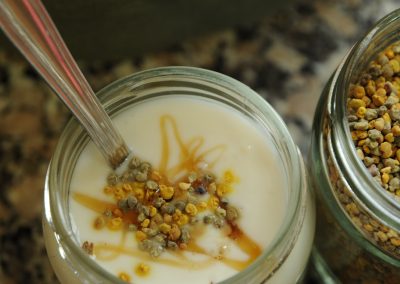The YogurtNest Story
By Miguel Leal It all started with my honey bees!
It all started with my honey bees!
Very little people know it, but the first YogurtNest came out from the transformation of a small French beehive, that I’ve adapted to make yogurt at home.
That hive was the product of a company called
The project was based on 5 fundamental principles:
- 1. Whenever possible, materials, tools and components would be sourced locally;
- 2. Outsource with local carpenters (which, at the time, due to the economic crisis, were on the brink of shutting down their businesses);
- 3. Make quality, durable products;
- 4. Avoid using high embodied energy materials, such as adhesives, paints and varnishes, reduce plastic and metal to the absolutely necessary;
- 5. Design the processes, so as to best manage material usage and avoid waste.
More than that, we actively campaigned for the bees and other pollinators, we organized dozens of talks, conferences and documentary exhibitions. We trained well over a hundred new beekeepers and I’ve even been invited to be a speaker at a TEDx Talk, on the importance of the bees!
People understood that we had a serious commitment to the Planet, and they came to us, interested in what we were doing. It has been extremely interesting to see how many of those people became, themselves, agents of change.
Hey! But, what about the
Well, I love yogurt, and I have been making it at home since 2008. Initially, with an expensive kitchen robot, which I bought for that purpose, but it was high on energy consumption and there were too many parts to wash, afterwards.
One day, as I was brainstorming about new ways to add value to the wood shavings generated by our hive making activity, I had this idea of adapting this Warré hive, using the wood shavings we got when we planed the wood boards for the hives.
At the time, I was leading a local Transition Towns‘ movement, and, one day, published an image of my 100% homemade breakfast (home-made bread, jams & yogurt) on our blog. I got an e-mail asking how I made the yogurt. As I had no idea if the person could buy the kitchen robot I had used, and he probably didn’t have a hive to adapt, I, basically, gave him directions to make something very similar to the 
The YogurtNest was born!
After an evolution process that spanned a few generations, it got its current shape, but its core was still made of wood shavings. It looked good, allowed me to re-use the glass jars I had at home and, most important, made great yogurt.
Then, one day, I had a milk spill, due to a jar that was not properly sealed. The wood shavings absorbed the milk, but that YogurtNest, which was not washable, ended up being composted. I would have to find a new soul for the
The Eureka moment of this story was the moment I had the idea of replacing the wood shavings with cork granules. Gone was that awkward sound generated by the wood shavings rubbing against each other; thermal performance had been, exceedingly, improved and – this is important! – cork had become such a highly regarded material that the
The new YogurtNest received an exciting welcome, from my circle of friends – everybody wanted one! Soon enough, I was getting inquiries from their friends, then from their friends’ friends, and so on… YogurtNests were, discretely leaving the garage where they were manufactured, reaching every corner of Portugal.
It wasn’t long until a few YogurtNests started to show up in Germany, Austria, France, Sweden, Italy and Estonia, with others, still, crossing the Atlantic Ocean, bound to North America. Yet, I never, really, tried to advertise the
This story showed me that as people understood the YogurtNest’s potential and the environmental philosophy behind it, they wanted to adopt it. They wanted to start making their own yogurt. They realized that the
So the time has finally arrived for the
I hope you will join us, in our quest to save the Planet!

 It all started with my honey bees!
It all started with my honey bees!


